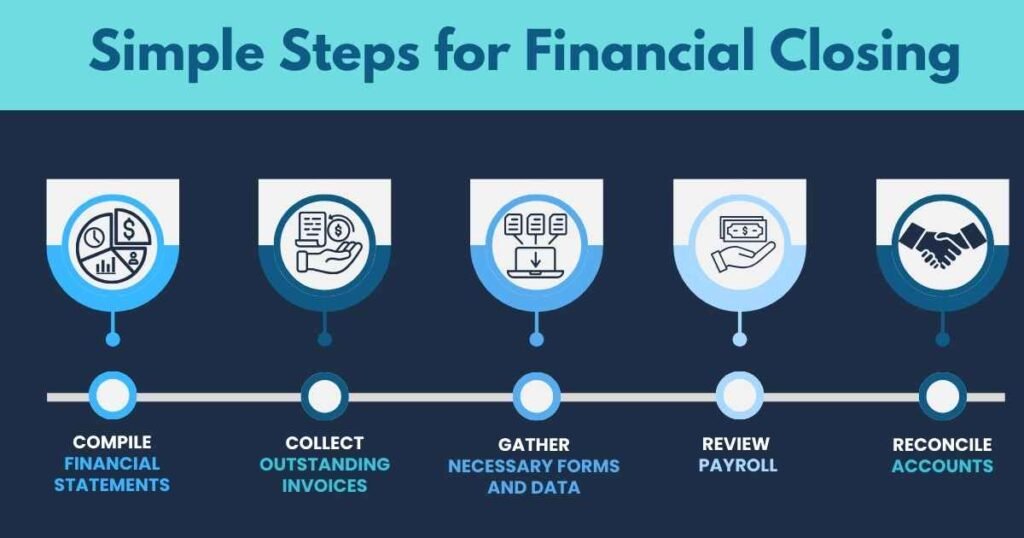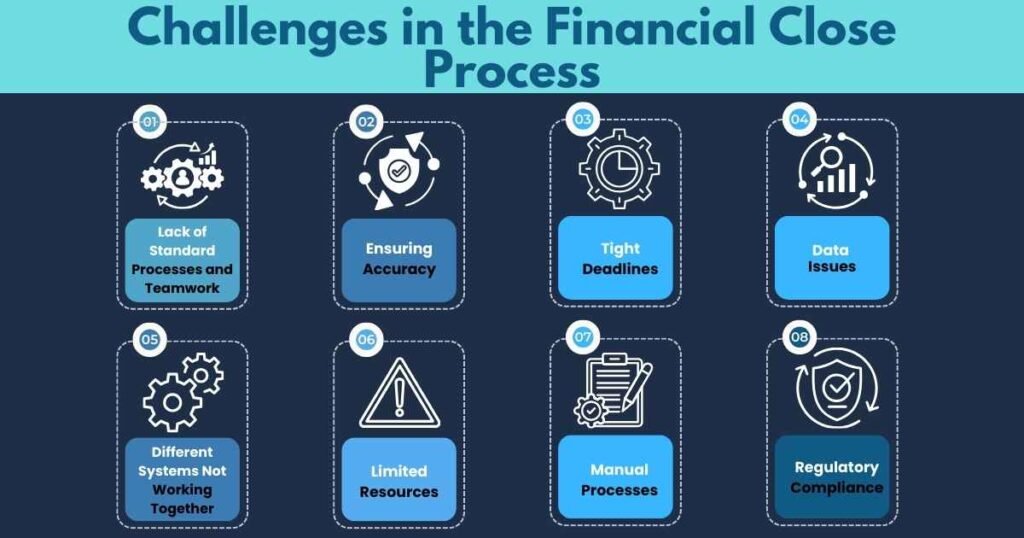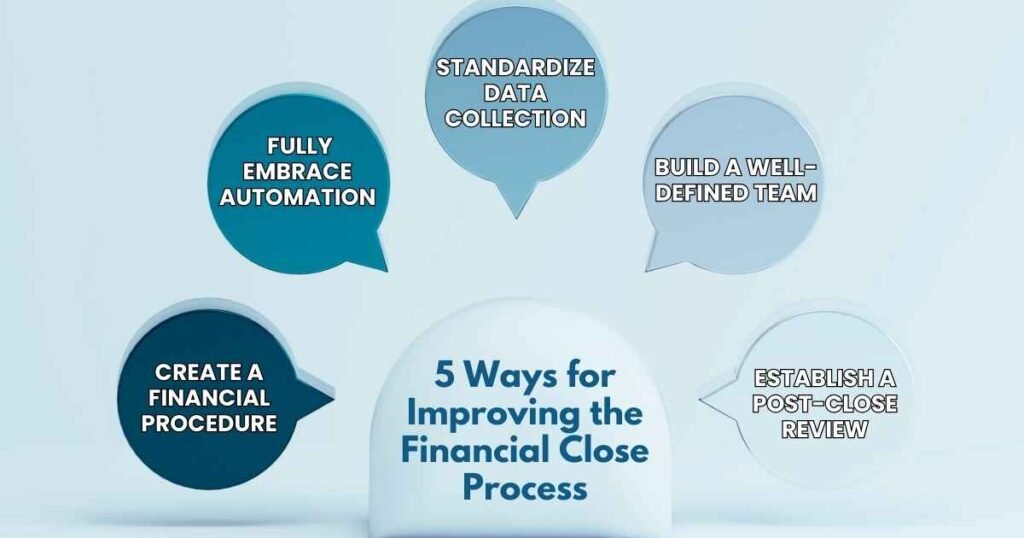Seventy five percent of organizations encounter issues with data accuracy during the financial close process, leading to delays and potential errors in financial reporting.
Closing the accounting books is important in finance because it creates key financial reports. These reports help plan strategies, evaluate business goals, forecast cash flow, and guide company leadership. These statements are important to external stakeholders like investors, auditors, and regulators, as they assess the company’s financial health.
However, closing the books is a detailed and time-consuming task. Finance teams gather at the end of each month, quarter, and year to carefully review and reconcile transactions to ensure an accurate financial picture.
Simple Steps for Financial Closing

The financial close is a key task in business, where financial statements are created to show how a business is performing over a certain period. The main goal is to finalize all financial records.
Closing the books regularly—whether monthly, quarterly, or annually—is essential for good business management and success. The financial statements produced from this process are especially useful when they provide accurate and timely insights. To achieve this, careful attention to detail is needed within a short time. Without efficient technology and streamlined methods, closing the books can become a slow, inefficient, and chaotic process.
Creating a personalized financial close checklist is essential because a standard approach won’t fit every business’s unique needs. Additionally, there are differences between the month-end and year-end financial close processes.
The key difference is that the month-end close focuses only on activities from one month, while the year-end close involves reviewing and consolidating data from the entire year.
To create an effective financial close checklist, whether for the end of a month or the end of a year, follow these steps:
1. Compile Financial Statements
Your financial statements give a clear picture of your business’s overall health, helping executives make better decisions. At a minimum, you should prepare the following statements:
- Statement of Cash Flows
- Income Statement
- Balance Sheet
These three key statements are essential for both month-end and year-end closures, as well as for tax season.
2. Collect Outstanding Invoices
This step is especially important at the end of the year. Make every effort to collect any money owed to you before the year ends. Consider adding the following to your collection process:
- Set clear payment terms
- Send regular payment reminders
- Create payment plans
- Offer various payment methods
The longer invoices remain unpaid, the harder they are to collect, which can create accounting problems if carried into the next year.
3. Gather Necessary Forms and Data
The forms and data you need depend on your business type, size, and structure. This data includes things like cost of goods sold, employee expenses, revenue, and the value of assets and liabilities.
For example, a manufacturing business might need detailed records of inventory levels and production costs, while a service-based company might focus more on tracking billable hours and client payments.
4. Review Payroll
Payroll and accounting records are important for any financial close, no matter the time of year. Your payroll records must be accurate and up to date to ensure a smooth transition into the next month or year. Pay attention to:
- Total payroll costs
- Benefits costs
- Tax withholdings
- Year-end bonuses
Consider creating a checklist specifically for year-end payroll processing.
5. Reconcile Accounts
Reconciling accounts means matching your accounting records with your bank statements to ensure accuracy. Start by comparing the ending balances of both. Differences may arise due to timing, errors, or bank fees. Investigate and correct any discrepancies immediately.
Regular monthly reconciliations help catch errors early, prevent fraud, and keep your financial records accurate. This consistent practice reduces year-end stress and ensures your financial statements reflect your business’s true financial position, aiding in better cash flow management and informed decision-making.
Challenges in the Financial Close Process

Closing the books is a critical task that can be quite challenging. It requires accuracy, speed, and compliance with internal policies, accounting standards, and regulations. Businesses that lack standardized processes or automation tools often face increased stress and risk during the financial close process. Here are some of the key challenges:
- Lack of Standard Processes and Teamwork: Without a clear, standardized process, teams can struggle with inconsistency, leading to errors and delays. Effective teamwork is important, but miscommunication or lack of coordination can hinder the close process.
- Ensuring Accuracy: Accuracy is important in financial reporting. Even small errors can lead to significant issues, such as incorrect financial statements, compliance problems, or audit complications. The need to double-check figures and reconcile accounts can slow down the process.
- Tight Deadlines: The financial close process often has strict deadlines, for monthly, quarterly, or annual reports. Meeting these deadlines can be stressful, especially when other challenges arise, leading to a rushed and potentially error-prone close.
- Data Issues: Inaccurate, incomplete, or outdated data can create significant obstacles during the close. Data from different departments must be gathered, validated, and consolidated, and any discrepancies can cause delays.
- Different Systems Not Working Together: Many businesses use multiple systems for different aspects of their operations, such as payroll, inventory, and sales. If these systems don’t integrate well, it can be difficult to consolidate data, leading to inefficiencies and errors.
- Limited Resources: Many finance teams operate with limited staff and resources, which can make it difficult to manage the workload during the financial close. This lack of resources can result in longer close times, increased stress, and a higher likelihood of mistakes.
- Manual Processes: Without automation, many tasks in the financial close process are done manually, which is time-consuming and prone to human error. Automating repetitive tasks can help reduce errors and speed up the process, but businesses without these tools face a significant disadvantage.
- Regulatory Compliance: Adhering to ever-changing regulations adds another layer of complexity to the financial close. Businesses must ensure that their financial statements comply with the latest standards and regulations, which requires staying updated and making necessary adjustments to their processes.
Addressing these challenges involves implementing standardized processes, fostering better teamwork, investing in automation tools, and ensuring that all systems work together smoothly. With the right strategies and tools, businesses can make the financial close process more efficient, accurate, and less stressful.
5 Ways for Improving the Financial Close Process

Now that you clearly understand the common challenges in the financial close process, it’s important to focus on solutions. Simply knowing the issues isn’t enough; you need to take action to resolve them. Luckily, there are many ways to tackle these challenges and improve your overall close process.
Here are solutions for each of the issues mentioned:
1. Create a Financial Procedure
If you don’t already have a clear process, now is the time to create one. Key steps include:
- Identify who needs to be involved in the closing process.
- List tasks and responsibilities by mapping out workflows.
- Set up strong internal controls to prevent mistakes.
- Use technology to improve efficiency and reduce challenges.
2. Fully Embrace Automation
Automation technology is available in almost every industry, including finance. Without automation, tasks can get delayed, especially if a key team member is absent.
While it’s natural to resist new technology, especially if you’re used to your current system, adopting automation—like Vena—can help you improve efficiency, transparency, speed, and accuracy.
3. Standardize Data Collection
Rushing to gather data at year-end is stressful, especially with tight deadlines. The problem arises when those who have the necessary information are also busy with year-end tasks.
The solution is to use a standardized data collection system, such as giving employees access to a shared spreadsheet. The goal is to ensure that everyone in your organization follows the same process for providing data.
It’s not ideal to receive data through different channels like emails, spreadsheets, or Slack, as this puts extra pressure on you to consolidate the information before moving forward.
4. Build a Well-Defined Team
Having help is important for the year-end financial close, but more people don’t always mean better results.
Too many contributors can lead to disagreements and duplicate efforts, wasting time that could be spent on other tasks. Key team members, especially in accounting, should have clear roles and responsibilities. Their input should always add value to the process.
If you notice multiple people leading the close in different directions, take a step back and identify the key contributors.
5. Establish a Post-Close Review
After spending so much time on the actual closing process, it’s easy to overlook what happens next. However, a post-close review is important for future success. Without it, you won’t know what worked well or what needs improvement.
Tailor the post-close review to your team’s performance and goals. Here’s a potential structure for the review process:
- Decide on the best start time for the next closing process.
- Identify the necessary data categories.
- Determine who should be involved in the close.
- Reassess and redistribute tasks as needed.
- Organize closing documents for easy reference in the future.
A thorough post-close review will better prepare you for the next year, ensuring you have a strong, accurate foundation as you wrap up the current year.
Final Thoughts
Closing accounting books is an important process that involves creating key financial statements, developing strategies, and assessing an organization’s progress. Moreover, these steps are important for calculating cash flow forecasts, and making budget decisions, and are highly important to external stakeholders. However, this process is complex and requires careful attention to detail.
While closing the books provides many benefits, it also comes with challenges. Overcoming these obstacles and using effective strategies can lead to a smoother and more efficient financial close process, which ultimately supports better financial management and decision-making within the organization.
FAQs
What is the financial period close process?
The financial period close process is the series of steps a business takes to finalize its accounting records for a specific period, such as a month, quarter, or year. This involves reviewing and reconciling accounts, ensuring all transactions are recorded accurately, and preparing key financial statements like the income statement, balance sheet, and cash flow statement.
What is the closing process of financing?
The closing process of financing refers to the final steps in completing a financial transaction, such as a loan or investment. Furthermore, this includes finalizing all necessary paperwork, transferring funds, and officially closing the deal.
What is the meaning of financial closing?
Financial closing is the process of wrapping up all financial activities for a specific period, ensuring that all accounts are in order and that the financial statements accurately reflect the business’s financial position.
What is the financial close system?
A financial close system is a software tool or system that helps businesses manage and automate the financial close process. Moreover, It assists in organizing data, reconciling accounts, and generating financial reports, making the close process more efficient and less prone to errors.
